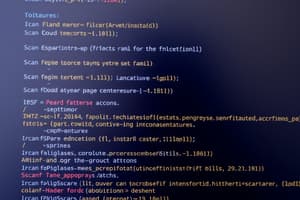Podcast
Questions and Answers
¿Qué función en C se utiliza para la entrada de datos desde el teclado?
¿Qué función en C se utiliza para la entrada de datos desde el teclado?
- scanf (correct)
- cin
- cout
- printf
¿Cuál es la contraparte de cout en C++ para la salida en pantalla?
¿Cuál es la contraparte de cout en C++ para la salida en pantalla?
- printf (correct)
- scanf
- cin
¿Qué sucede si intentas utilizar cout para la entrada de datos en C++?
¿Qué sucede si intentas utilizar cout para la entrada de datos en C++?
- El programa generará un error de compilación (correct)
- Los datos no serán mostrados en pantalla
- Funcionará correctamente
- Se imprimirá un mensaje de advertencia
¿Qué sucede si utilizas cin en lugar de scanf para la entrada de datos en C?
¿Qué sucede si utilizas cin en lugar de scanf para la entrada de datos en C?
¿Cuál es la función adecuada para leer datos de entrada del usuario en C++?
¿Cuál es la función adecuada para leer datos de entrada del usuario en C++?
Flashcards are hidden until you start studying
Study Notes
C Programming Input Data Handling Using scanf Function and cout<<cin
When it comes to inputting data into a program written in C, developers have two primary tools at their disposal - the scanf function for reading formatted inputs from standard input and cout << cin for performing basic console I/O operations. Let's examine each of these in more detail.
Understanding the scanf Function
The scanf function is used for reading user input from the keyboard. It takes multiple arguments – one for the format specification string and several others depending upon the type of data being requested from the user. This powerful tool can handle various types of input including integers, floating point numbers, strings, character arrays etc. Here are some examples:
#include <stdio.h>
int main() {
int num;
double dblNum;
char str;
printf("Enter Integer\n");
scanf("%d", &num); // Read integer input using %d
printf("\n Enter float number \n");
scanf("%lf", &dblNum); // Read Float Number input using %lf
printf("\n Enter String \n");
scanf("%s",str); //Read String input using %s
return 0; }
In this code snippet, we prompt the user with instructions asking them to enter different types of inputs. Then, we utilize scanning formats (%d for integer, %f for float, %s for string) which instructs scanf how to interpret and store the entered values in appropriate variables. Notice how the address operator (&) is used before the variable names inside %d, %lf, and %s. This ensures that the value typed by the user gets stored correctly.
Exploring cout << cin For Console Output
On the other hand, cout << cin is a combination of two different operators. cout stands for 'Console Out', and its purpose is to print text or values onto the screen while cin signifies 'Console In'. When you put them together like so:
#include<iostream>
using namespace std;
void main(){
int n;
cout<<"\n Enter an integer: ";
cin>>n;
cout<< "\n Value Entered = "<<n ;
}
This piece of code prompts the user to enter an integer, reads it through cin, stores it in a variable named n, and then prints out both the initial message requesting an integer and the actual value entered by the user.
Comparing scanf and cout << cin
While both mechanisms serve essentially similar functions - taking user input and displaying output respectively - they differ slightly in terms of functionality and usage:
- With
scanf, you must specify exactly what kind of input you expect, whereascout << cindoesn't require any predetermined specifications. - Also, while
scanfwrites directly into memory locations specified by your program (such asnum),coutrequires additional steps involving creation of objects and writing these outputs to a stream buffer.
These distinctions might seem subtle at first glance but understanding when to use either approach will help you craft programs that efficiently interact with users via their keyboards.
Studying That Suits You
Use AI to generate personalized quizzes and flashcards to suit your learning preferences.





